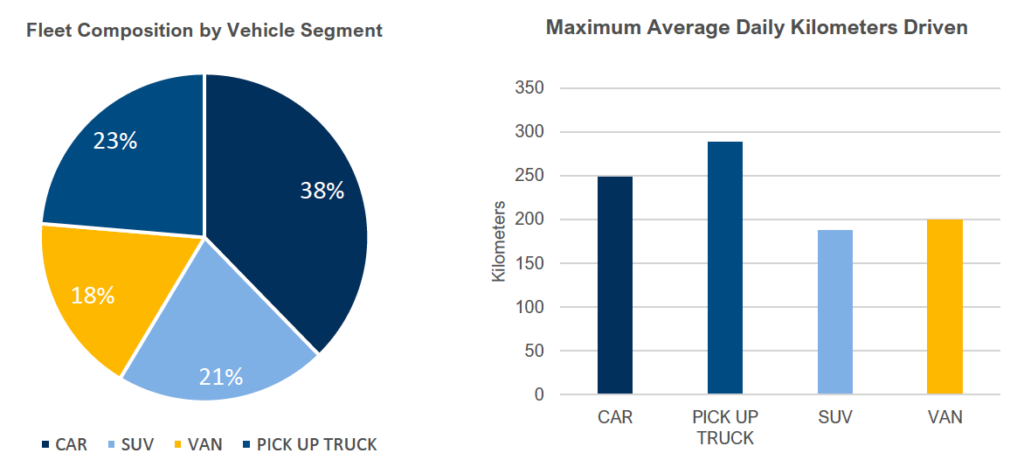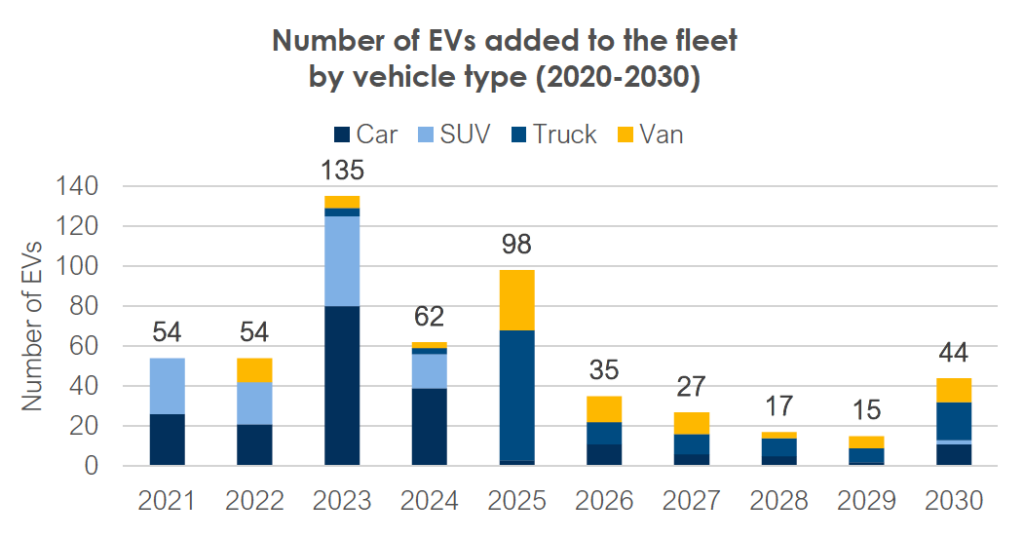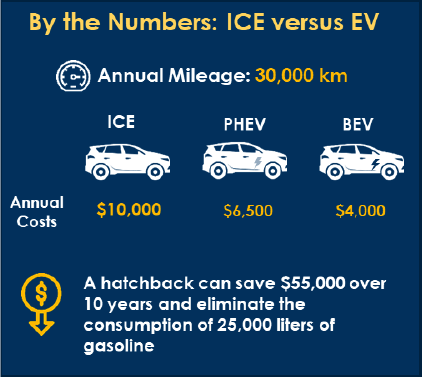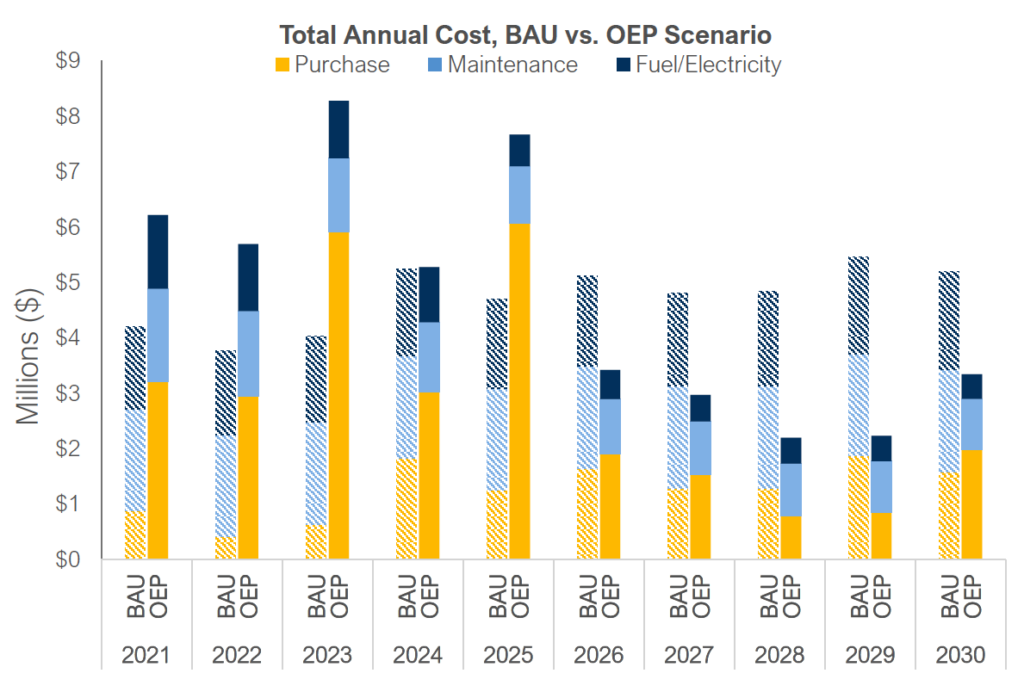Organization: Halifax Regional Municipality
Consultant: Dunsky Energy + Climate Advisors
Fleet size: 541 vehicles
Sector: Municipality
Stage in electrifying fleet: Plan adopted
Vehicle types: Cars, pickup trucks, vans, sport utility vehicles
Fleet electrification helping greater municipal goals
In a place where electric vehicle adoption once lagged compared to other North American cities, the Halifax Regional Municipality has become a leader in putting EVs onto the streets.
In 2016, transportation accounted for 20 per cent of community emissions in the Halifax region. Four years later, Halifax council approved a long-term climate plan to reduce emissions and help the region adapt to a changing climate. In the HalifACT plan, city officials tasked themselves with devising a municipal EV strategy that would curb carbon transportation emissions.
The Halifax Regional Municipality brought in Dunsky Energy + Climate Advisors, a clean energy research and consulting company, which produced a comprehensive plan for how to implement a robust public charging infrastructure, EV policies, advocacy and light-duty fleet electrification. The plan is a template for other cities and fleet managers looking to expand their electric fleet, practically from scratch. Here’s how the Halifax region plans to convert their municipal fleet to electric and make EVs a bigger part of their city.
A data-driven electrification plan
Dunsky used an EV Adoption Model to determine the feasibility of Halifax decarbonizing their corporate fleet by 2030. Dunsky compared EV strategies in other jurisdictions (including Montreal, Toronto, and Victoria), quantified the impact of policies and rebates, assessed grid impacts and charging costs and made the business case for investment plans. As of 2020, the fleet consisted of 541 vehicles ranging from cars to vans and sport utility vehicles.
Dunsky analyzed the existing Halifax fleet by vehicle type (car, pickup truck, SUV, van) and determined the average daily distance driven by each type, across the fleet. The key takeaway here was that these distances were all within the range of a typical EV. Leveraging their Fleet Electrification Optimization model, known as E-FLEET, Dunsky was then able to draft a fleet electrification roadmap to meet the city’s goal of 100 per cent electrification by 2030.

From zero to 100 per cent ZEV in 10 years
The fleet electrification roadmap plotted a course to gradually replace every combustion-engine vehicle in the Halifax fleet with a battery electric vehicle or plug-in hybrid electric vehicle. The first two years of the plan included a 10 per cent EV replacement – the pace of a pilot. EV replacement jumped to 25 per cent in years three and four, making the bulk of the transition in the first five years.

Dunsky’s fleet electrification model considers a wide range of factors – acquisition price, vehicle availability, operating costs, the best time to replace a vehicle – and noted that the accelerated roadmap devised for the Halifax Regional Municipality was “an indication of the positive business case for EVs despite their higher initial investment.”
Balancing the higher purchase cost of EVs
Setting a course so far in advance made it possible to predict the expenses associated with EV acquisitions (and sales of retired ICE vehicles) and to foresee fleet operation costs over the course of the plan. Dunsky found that the lower operating costs for EVs – fuel and maintenance – plus higher resale value for the vehicles would reduce overall fleet operation costs as the transition neared completion.

Currently, acquiring an EV means a cost premium of about 30 per cent compared to a similar gas vehicle. However, Dunsky estimated that cost premiums will drop year-over-year as the EV industry continues to grow. Additionally, savings in fuel and vehicle maintenance will lower total cost of ownership compared to current gas-powered fleet cars.

EV costs to fall starting in 2026
According to Dunsky, beginning in 2026 the purchase, maintenance, and electricity cost will decrease substantially. Dunsky forecasted that a 100 per cent EV fleet would cost Halifax roughly $7.5 million in 2025, about $3 million more than a “business-as-usual” fleet. However, the cost of an all-EV fleet is projected to fall to a little over $3 million in 2026, and hover around $2 million to $3 million throughout the rest of the decade.
When all is said and done, the HalifACT plan will also have a substantial impact on the environment, especially when additional education and charging infrastructure programs to foster public EV adoption are factored in. By transitioning its fleet to fully electric by 2030, the Halifax region’s greenhouse gas emissions will drop by more than 60 per cent over the next eight years.

In the next article, get the bigger picture on rebates, subsidies and other supports available across Canada.
Reproduction of any or all of this material is strictly prohibited without permission. Please contact fleets@electricautonomy.ca for inquiries. Copyright © 2025 – Electric Autonomy Canada – ArcAscent Inc. – All Rights Reserved
Want to learn more? Sign up or log in so you can track your progress, earn a course certificate and receive exclusive invitations to our live learning sessions.